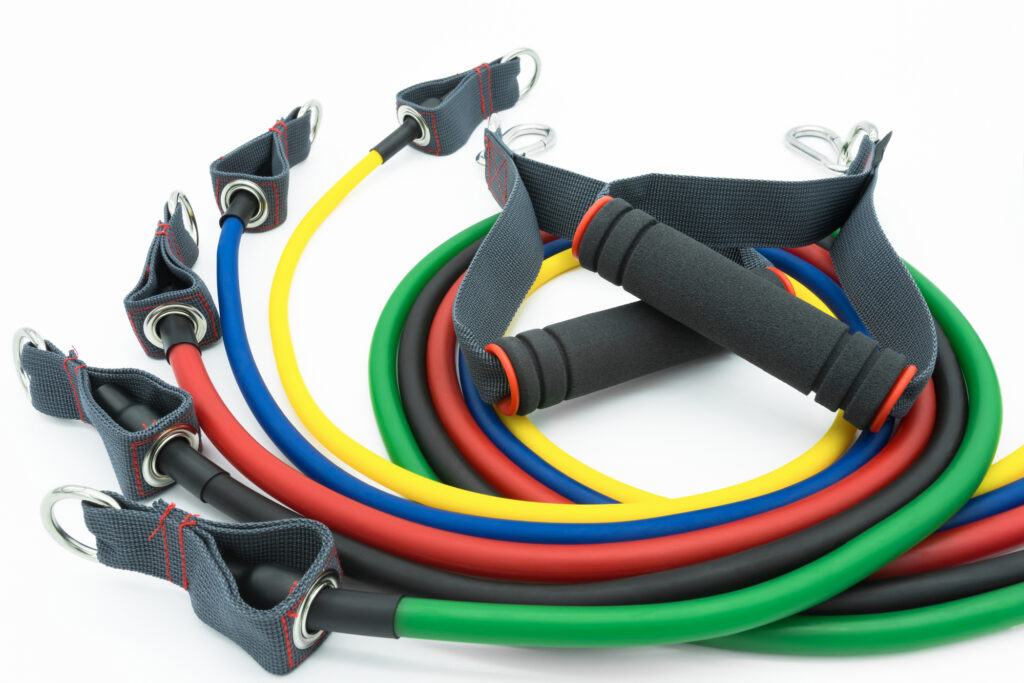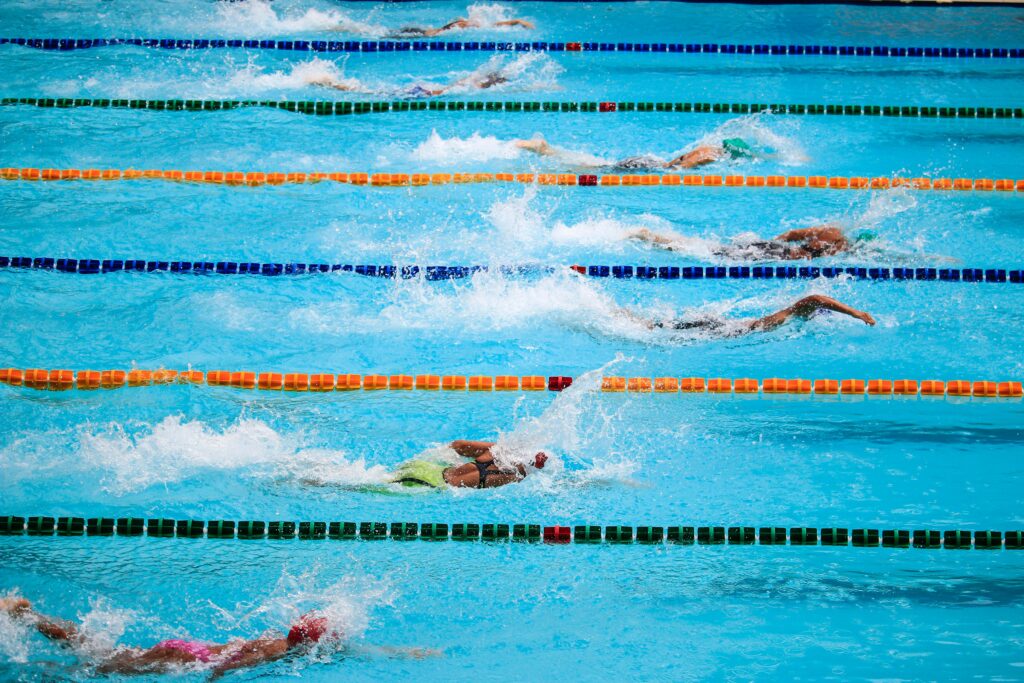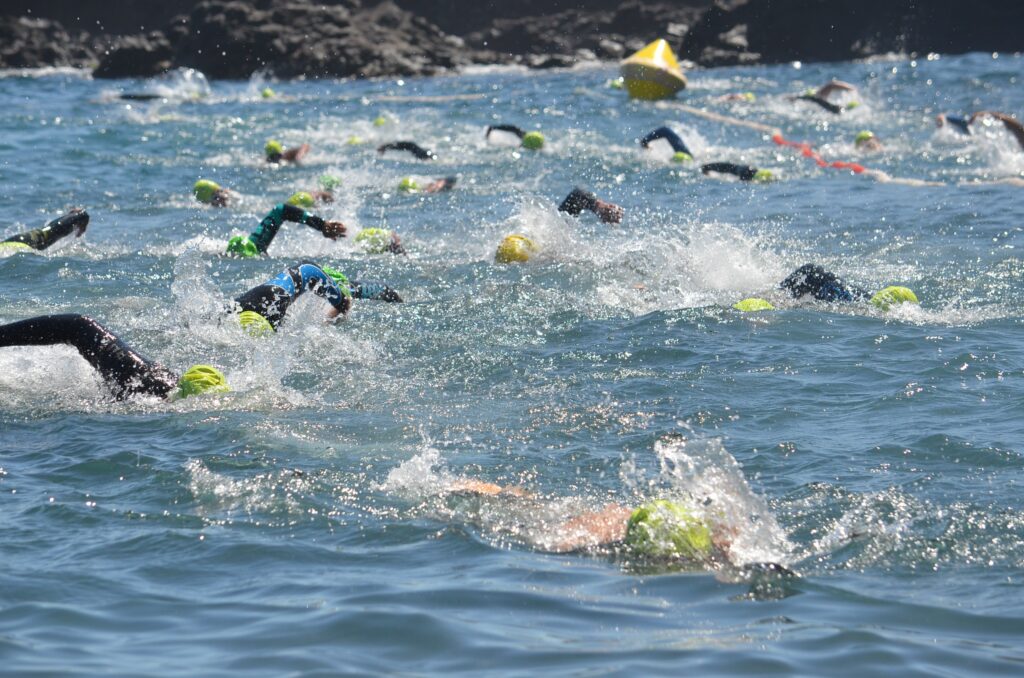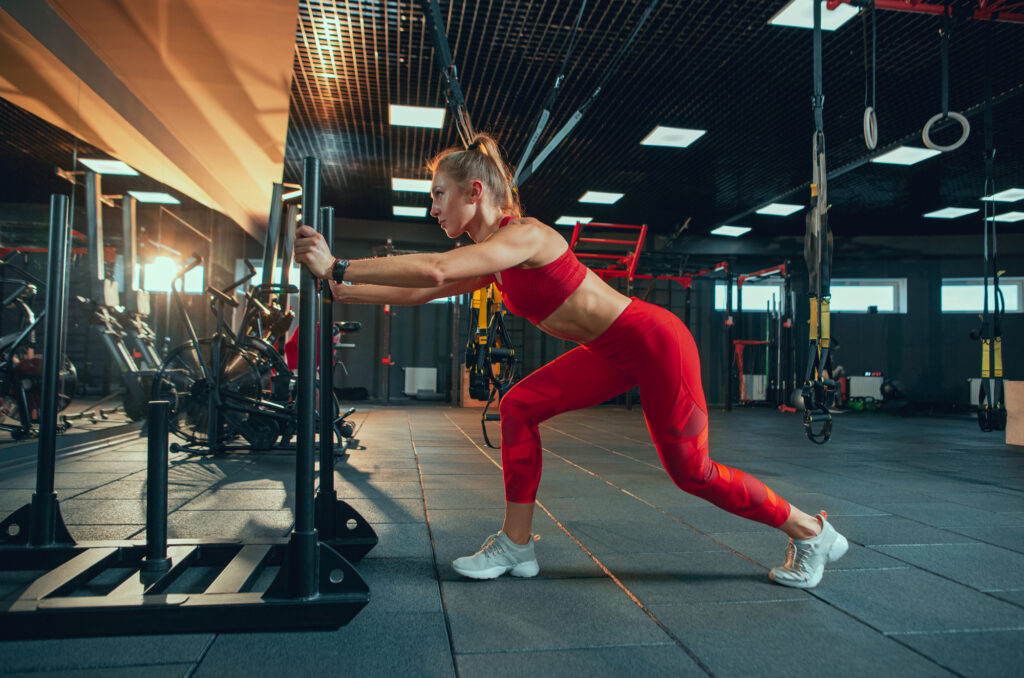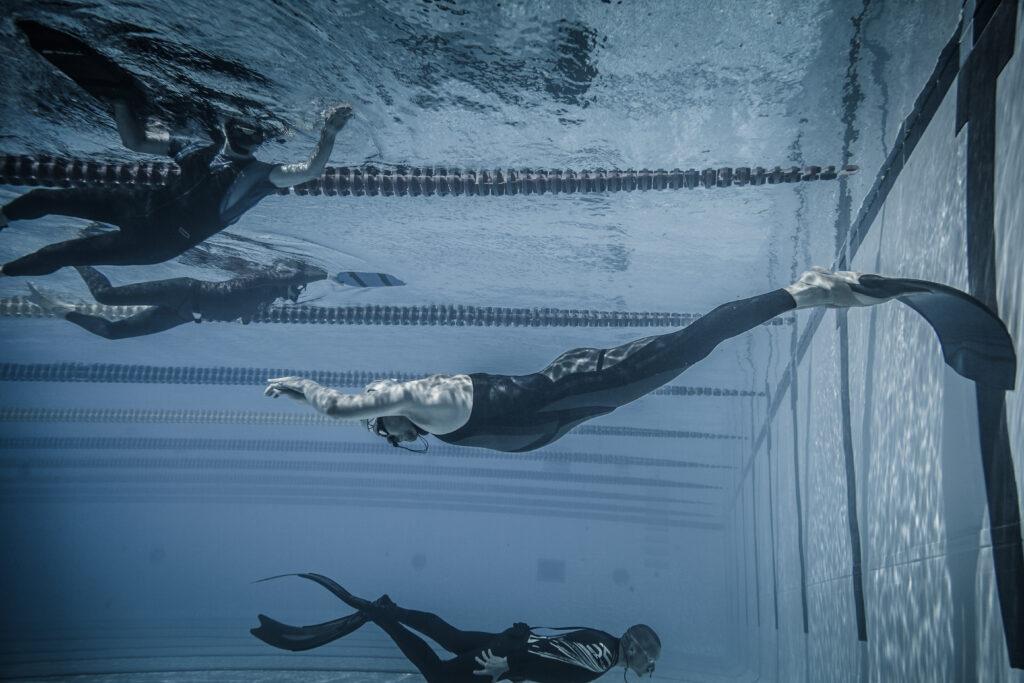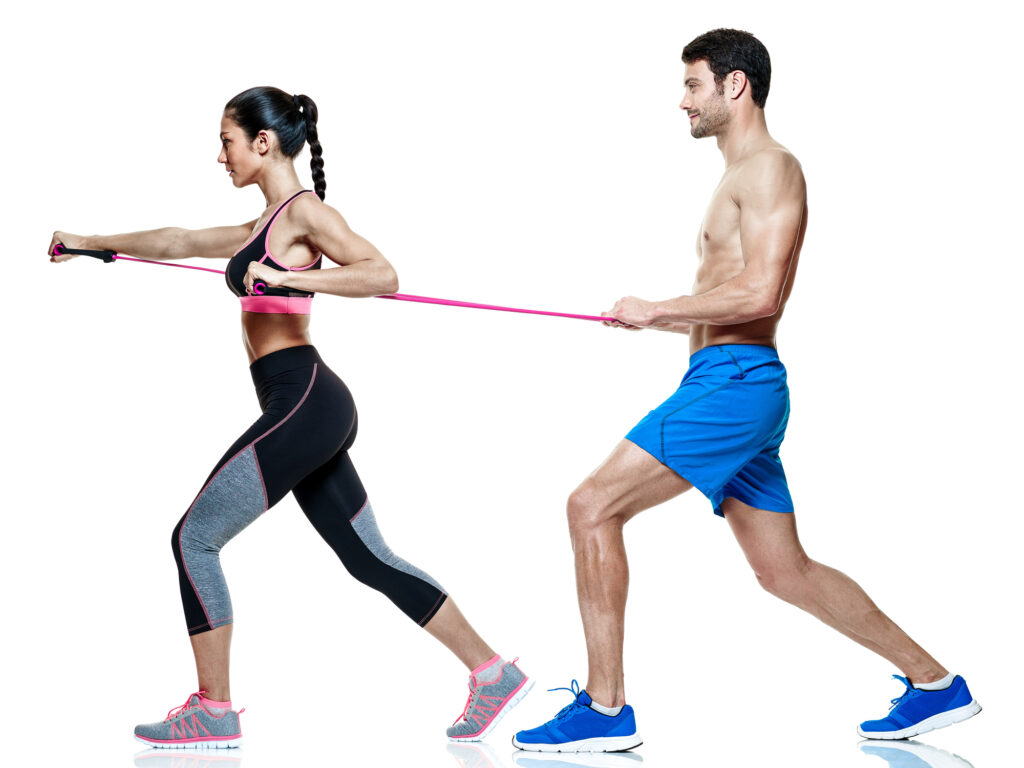
Swimmers often seek to enhance their water performance through various dryland training methods. Resistance band exercises provide an ideal solution for a full-body workout that specifically caters to the needs of swimmers. These workouts not only improve strength and power but also offer the flexibility and muscle endurance that swimmers require. The use of resistance bands for such exercises has been shown to be beneficial in building muscle, core stability, and thus contributing to better swimming performance.
A tailored resistance band workout for swimmers targets key muscle groups used during swimming strokes. It encompasses exercises designed to fortify the shoulders, back, chest, hips, and legs. This type of training allows for mimicking swimming motions on land, enabling athletes to practise and improve their technique while building strength. Additionally, resistance band training can be adjusted to cater to various fitness levels, making it an effective workout option for both novices and experienced swimmers.
Incorporating resistance band exercises can be an essential component of a swimmer’s training regimen. By focusing on exercises that replicate in-water movements, swimmers can develop a more powerful stroke and improve their overall fitness. As these workouts can be performed almost anywhere, they offer a convenient and efficient way to train, providing a structured approach to enhance swimming prowess.
Essentials of Resistance Band Training
Resistance band training is pivotal for building strength and muscle, tailored specifically for swimmers who require both resistance and flexibility from their fitness equipment. Understanding the nuances of these bands and choosing the right type is essential to maximise the benefits.
Understanding Resistance Bands
Resistance bands are versatile fitness equipment offering varying degrees of resistance to cater to different strength levels. They are elastic bands used for strength training exercises, which can substitute free weights and machines. The bands come in a breadth of types, including tube bands with handles, loop bands, and therapy bands. Identifying appropriate resistance levels – typically indicated by the band’s colour – is crucial for effective training sessions.
Benefits for Swimmers
Swimmers can reap considerable benefits from resistance band exercises, as they target muscle groups critical for swimming. Training with these bands can enhance a swimmer’s core strength, improve flexibility, and offer the resistance needed without straining joints. Movements like pulls to mimic the swimming stroke utilise the bands to train with a focus on the pull-through motion in the water, which is essential for efficient swimming.
Selecting the Right Band
Choosing the best resistance band is influenced by the swimmer’s current strength and the desired intensity of the workout. Bands are categorised by resistance levels ranging from light to extra-heavy, enabling a customised approach to training. Swimmers should start with a band that challenges their muscles whilst allowing them to complete a full range of motion with proper form. As their strength improves, they can opt for bands with more resistance to continue progression. Loop bands are particularly favoured for their versatility and ease of use for full-body workouts.
Warm-Up Exercises
Before diving into resistance band exercises for swimmers, it’s crucial to understand the significance of warming up the body. A proper warm-up primes the muscles for the strenuous activity ahead, reducing the risk of injury and increasing overall performance.
Importance of a Proper Warm-Up
A proper warm-up is essential for swimmers to prepare their muscles and joints for the intense activity of swimming. It increases blood flow to the muscles, enhancing oxygen delivery and nutrient supply. This process steadily raises the body temperature and prepares the muscles for a full range of motion, which is crucial in a sport that requires extensive flexibility and strength. Incorporating warm-up exercises with resistance bands can add a dynamic component to the routine, engaging the muscles in a sports-specific manner.
Dynamic Warm-Up Routines
Dynamic warm-ups involve movement-based stretching that is particularly effective for swimmers. Such routines should focus on all major muscle groups and mirror the movements involved in swimming.
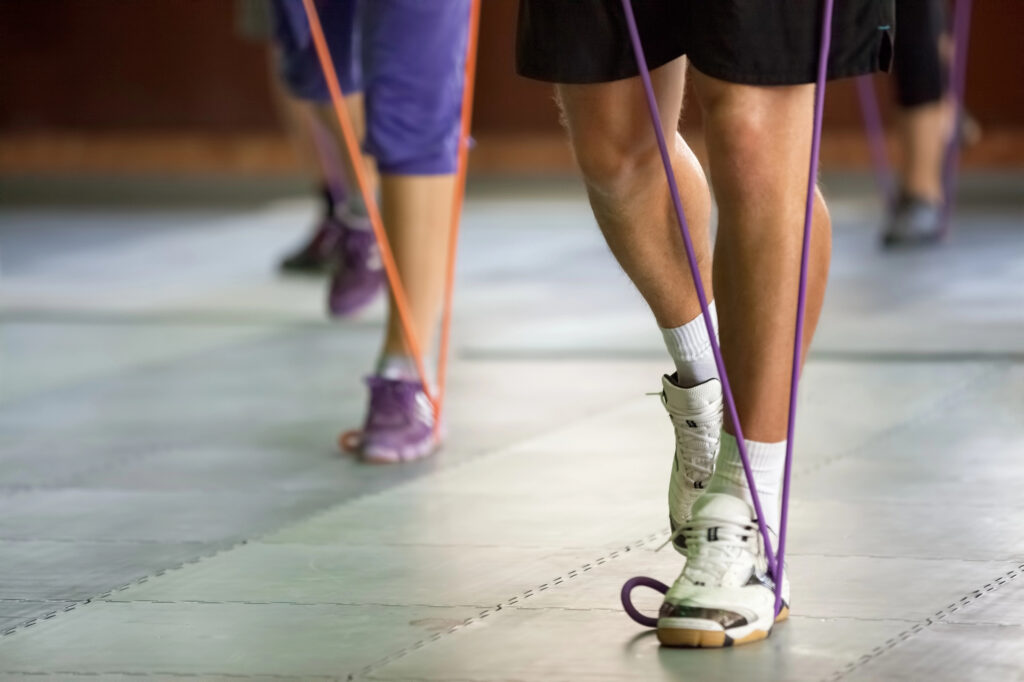
For the upper body:
- Arm Circles: Stand with feet shoulder-width apart and extend arms to the sides. Perform small circles that gradually get larger, for 30 seconds. Then change direction for another 30 seconds.
- Band Pull-Aparts: Hold a resistance band with both hands in front of you at shoulder height and pull it apart, retracting the shoulder blades. Perform 2 sets of 15 repetitions.
For the lower body:
- Leg Swings: Hold onto a stable object for support and swing one leg forward and backward. Do 15 swings for each leg.
- Band-assisted Squats: Step on the resistance band and hold the other end with both hands at shoulder height. Perform a full squat, ensuring the knees don’t go past the toes. Aim for 2 sets of 12 reps.
To warm up the core and improve coordination, one can use the dynamic warm-up described in SwimCompetitive.Com’s guide, such as light kicking with a kickboard to loosen up the legs.
Dynamic routines not only prepare the swimmer’s body but also engage the nervous system, enhancing neuromuscular readiness for the workout or competition ahead. They make an ideal starting point before proceeding to resistance band exercises specifically tailored for swimmers.
Core Resistance Band Workouts
For swimmers, core stability is crucial for efficient strokes and turns. Resistance band workouts offer an effective way to build this foundational strength. The following exercises target the core using resistance bands in a manner that complements swimming techniques.
Pallof Press
The Pallof Press is a key exercise for enhancing core stability. Athletes perform this movement by standing in a split stance and stretching a resistance band held at chest level, then pressing the bands forward. This action resists rotation, which is vital for a swimmer’s core during strokes. For detailed execution, visit Band Pallof Press.
Band Pull-Apart
This exercise focuses on the upper back and shoulders, but also engages the core. The swimmer should stand straight with arms extended horizontally at chest level, gripping a resistance band with both hands. By pulling the band apart while keeping the arms straight, one activates the posterior shoulder muscles and reinforces core engagement to maintain posture. View the correct form at Band Pull-Apart.
Band Squat
The Band Squat is a compound movement that helps develop lower-body strength and core stability simultaneously. One performs this by standing on a resistance band with feet shoulder-width apart and squatting while holding the band with both hands at shoulder level. As the athlete stands up, they press the band overhead, which involves the entire body, highlighting the importance of a strong core in the process. To see proper technique, check out Band Squat.
By incorporating these exercises into their fitness regimen, swimmers can expect improved core strength and stability, translating into better in-pool performance.
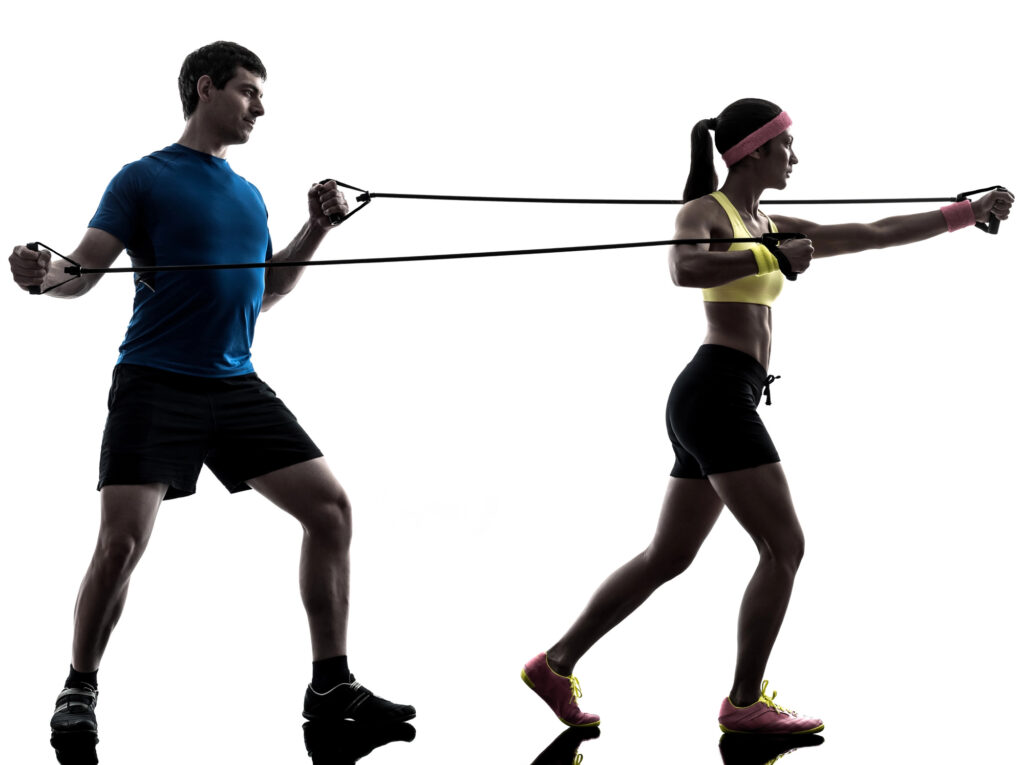
Upper Body Exercises
Utilising resistance bands for upper body exercises can notably enhance a swimmer’s pull and overall swimming performance. These exercises specifically target the muscles used during strokes in the pool, helping swimmers develop strength and endurance.
Chest Press
The chest press with resistance bands works the pectoral muscles, vital for a powerful swim pull. Athletes anchor the band behind them and press forward until their arms are fully extended, then return with control. Consistent practice can improve the proficiency of their strokes.
Overhead Press
Incorporating the overhead press, swimmers can build shoulder and tricep strength, both critical for effective swimming performance. They perform this by standing on the band and pushing upwards until the arms fully extend. This exercise complements the shoulder press, targeting similar muscle groups.
Pull-Aparts
The pull-apart is exceptional for targeting the rear deltoids and upper back, which stabilises the shoulder girdle. Athletes hold the band with both hands in front of them and pull it apart until it gently touches the chest, then slowly release. This action is essential for a balanced muscular development around the shoulders, reducing the risk of injury.
Lower Body Exercises
For swimmers aiming to enhance their performance, resistance bands offer effective workouts to target and strengthen the lower body, specifically vital areas like the glutes, quadriceps, and hamstrings. Resistance band training can significantly bolster leg strength, essential for powerful kicks and starts.
Deadlifts and Squats
Deadlifts are foundational resistance band exercises that focus on the posterior chain, including the hamstrings and glutes. To execute a band deadlift, one should stand on the band with feet shoulder-width apart, then grip the band’s ends and stand upright, maintaining a slight bend in the knees and driving through the heels.
Band Squats, on the other hand, emphasise the quadriceps and glutes. During a squat, the band should be placed just above the knees or around the thighs, challenging the leg muscles as one performs the squat by bending the knees and lowering the hips as if sitting back into a chair, then rising back up.
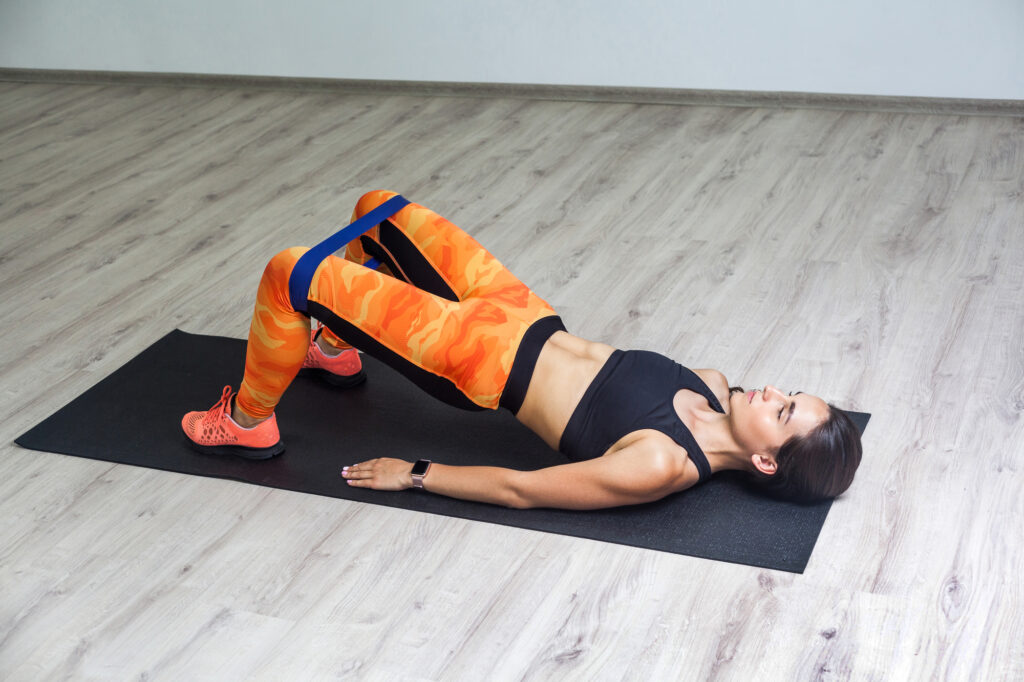
Glute Bridge
The Glute Bridge is a targeted exercise to build strength in the glutes. When incorporating a resistance band, placement is around the thighs just above the knees. The individual then must lie on their back with knees bent, feet flat on the ground, and press their hips upwards, creating a bridge. The resistance band adds an extra challenge, requiring the knees to push outwards and engage the glutes more intensely.
Strength and Power Development
Resistance bands offer versatility for swimmers looking to enhance their strength and power, which are critical components for improving performance in the water. These bands provide variable resistance, aiding in the development of muscle hypertrophy and power without the need for heavy weights.
Building Swim-Specific Strength
Resistance bands are highly effective for conducting swim-specific strength exercises. They mimic the resistance felt in water, allowing swimmers to target the muscle groups used in swimming strokes. For example, one can perform band pull-aparts or resistance band exercises for swimmers to strengthen their back and shoulders, which are crucial for the pull phase of all swimming strokes. Consistent training with these bands can lead to increased muscle endurance and swim strength over time.
- Key Exercises:
- Lat pull-downs
- Band pull-aparts
- Chest flys
Repetition Range: 8-12 reps for hypertrophy
Explosive Power Moves
Developing explosive power is about training muscles to produce maximum force in a short burst, essential for starts and turns in swimming. With resistance bands, one can incorporate movements that enhance this explosive strength. This can include squat jumps and broad jumps, adding a resistance band to increase the challenge and the power output of each leap. Such exercises contribute to faster off-the-block starts and more powerful push-offs from the pool wall.
- Key Exercises:
- Banded squat jumps
- Chest press throw
- Banded broad jumps
Training Tip: Focus on quick, powerful movements with full recovery between sets to train the fast-twitch muscle fibres.
Flexibility and Range of Motion
Incorporating resistance bands into a swimmer’s training can significantly enhance flexibility and improve swim-specific range of motion. These elements are crucial for efficient and powerful strokes in the water.
Enhancing Flexibility
Resistance bands serve as a valuable tool for swimmers looking to increase their flexibility. By providing variable tension, they allow for dynamic stretching that can be carefully controlled. Swimmers can perform stretches for various muscle groups, such as shoulder stretches, which may involve holding the band in both hands and gently pulling the arms apart to stretch the shoulders and upper back comprehensively.
Improving Swim-Specific Range of Motion
Using resistance bands can help swimmers develop a greater range of motion, which translates to more efficient swimming techniques. Specific exercises, like band-assisted pulls and stretches, mimic swimming strokes and can target the exact muscles used during swimming. These exercises enable a swimmer to work through a complete range of motion, potentially increasing mobility in the shoulders and hips, which are critical for strokes like the freestyle or butterfly.
Injury Prevention and Recovery
Incorporating resistance bands into a full body workout is an effective strategy for preventing injuries and promoting recovery in swimming. Emphasising proper technique and addressing muscle imbalances can reduce the risk of overuse injuries.
Addressing Muscle Imbalances
Swimmers often develop muscle imbalances due to the repetitive nature of the sport, which can lead to overuse injuries. Resistance bands are instrumental in balancing muscle strength on both sides of the body. For instance, when swimmers use resistance bands in exercises like resistance band exercises for swimmers, they work opposing muscle groups evenly, fostering symmetry and functional strength which are essential for optimal swimming performance.
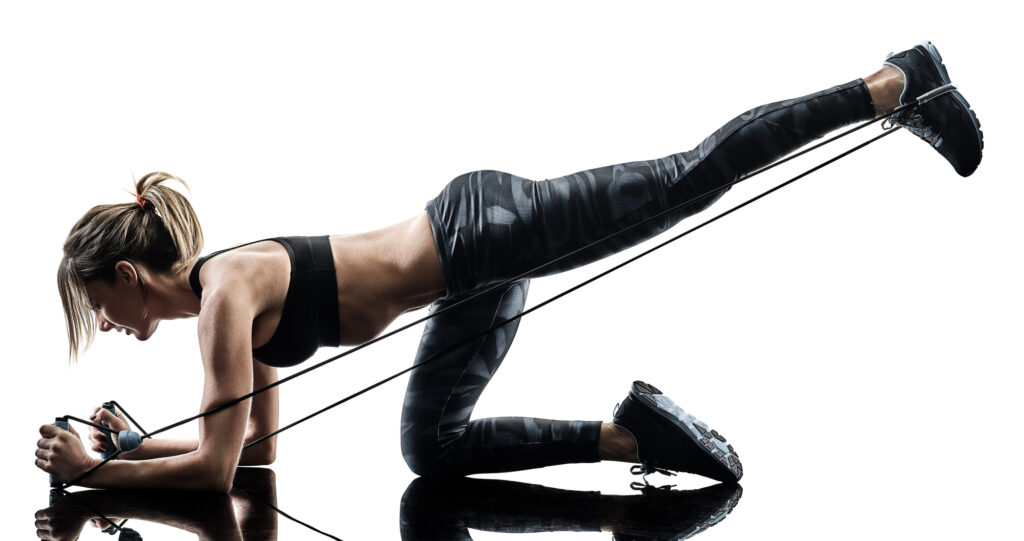
- Commonly Neglected Muscle Groups:
- Rotator Cuff
- Lower Back
- Hip Flexors
Exercises with resistance bands that target these areas can help in creating a balanced muscle structure, thus reducing injury risk.
Techniques for Muscle Recovery
Effective recovery techniques are crucial for injury prevention and ensuring swimmers return to the pool in optimal condition. Utilising resistance bands in recovery workouts helps to gently work the muscles, improving circulation and aiding in the elimination of lactic acid. The recovery swim workout mentioned in the provided search results can be adapted to integrate resistance band exercises that are low intensity and help in muscle recuperation.
- Recovery Band Exercise Example:
- Gentle Pull-Aparts: 3 sets of 15 reps
- Band-Assisted Stretches: Hold each stretch for 30 seconds
Ensuring proper technique during these exercises will aid in the recovery process while also preventing the introduction of new stress to the muscles.
Dryland Training Strategies
Dryland training is pivotal for swimmers seeking to enhance their water performance using exercises that replicate swimming movements. Resistance bands are indispensable tools in these workouts, providing variable resistance, functional strength, and flexibility enhancement.
Integrating Resistance Bands
Resistance bands bring versatility to dryland training, allowing swimmers to mimic in-water strokes and build swim-specific muscles. Coaches often recommend exercises such as band pull-aparts, which engage the shoulder blades and improve posture critical for swimming efficiency. For a swimmer’s lower body, exercises like monster walks strengthen hip abductors, directly translating to stronger kicks in the water. An essential movement involves arm extensions, similar to a swim stroke, using bands to create resistance as one extends their arms, which bolsters the upper body’s endurance and power.
Workout Frequency and Variation
The frequency of resistance band workouts should align with a swimmer’s training cycles, typically incorporating 2-3 dryland training sessions per week. Variation in exercises is crucial to avoid plateaus and to keep the muscles adapting:
- Monday: Emphasis on lower body with squats and lunges.
- Wednesday: Upper body focus, with push-pull movements replicating swimming strokes.
- Friday: Core and agility workouts, using bands for rotational exercises and planks.
Coaches should ensure that exercises evolve in complexity and resistance as the swimmer advances, maintaining a balance between strength and flexibility to prevent injuries. Regular changes in workout routines also keep swimmers engaged and challenged.
Advanced Training Techniques
When it comes to enhancing strength and performance in swimming, advanced training techniques using resistance bands can be particularly effective. These methods, tailored by certified personal trainers and employed by elite athletes, focus on improving overall fitness levels through strategic exercises.
Progressive Overload Principles
Progressive overload involves gradually increasing the resistance or the number of repetitions in training to continuously challenge the muscles, leading to increased strength and endurance. Implementing progressive overload with resistance bands can be achieved by varying band thickness, which changes the level of difficulty, or by increasing the number of sets and reps. For instance, when utilising resistance bands for swim-specific exercises, one might start with a medium-thickness band for sets of 8-12 reps, and progressively move to thicker bands or more repetitions over time.
Combining Bands with Free Weights
Incorporating resistance bands with free weights, such as dumbbells or kettlebells, allows for a more dynamic range of motion and targeted muscle engagement. One can perform combined exercises such as a “band-assisted free weight squat”, where a resistance band is looped under the feet and over the shoulders, while holding a kettlebell or dumbbell for added weight. This method increases the resistance during the ascent of the squat, further challenging the muscles and enhancing core stability—an essential aspect for swimmers’ fitness levels.

Tailoring Workouts to Individual Needs
When incorporating resistance bands into a full-body swimming workout, it’s critical to consider an individual’s fitness level and specific stroke technique. Adjusting programs ensures the workout enhances performance without increasing the risk of injury.
Customising for Fitness Levels
Beginners should focus on mastering resistance band exercises with light tension, emphasising proper form. For example:
- Leg Kicks: Moderate resistance bands can replicate kicking motions while lying on the back.
- Arm Stretches: Using lower tension bands for overhead stretches enhances shoulder flexibility.
Intermediate swimmers may increase resistance and complexity:
- Lateral Walks: Stronger bands around the ankles can improve hip flexor strength.
- Rowing Motions: Simulate the pull in swimming to build back and bicep muscles.
Advanced athletes might integrate higher resistance and explosive movements:
- Sprint Starts: Execute quick, powerful starts using high-resistance bands for propulsion exercises.
- Power Pulls: Mimic swim stroke power phases with heavy bands for increased muscle engagement.
Adapting Exercises for Swim Strokes
Each swimming stroke has distinct movements; therefore, resistance band exercises can be tailored accordingly:
- Freestyle: Focus on continuous arm circles using bands to mimic the stroke’s catch and pull phase.
- Backstroke: Incorporate resistance bands in overhead pulling exercises to build backstroke-specific muscles.
- Breaststroke: Utilise bands for adductor and abductor strengthening critical for the breaststroke kick.
- Butterfly: Simulate the butterfly’s undulating movement through resistance band drills that target the core and deltoids.
Apps like MySwimPro can provide guidance on stroke-specific exercises, ensuring that home workouts with resistance bands dovetail seamlessly with individual swim training regimes. By targeting the correct muscle groups and mimicking the specific mechanics of each stroke, swimmers can achieve a balanced workout routine that aligns with their personal fitness goals.
Performance Analysis and Improvement
Incorporating resistance bands into a swimmer’s training regimen advances not only strength but also technique, greatly aiding in performance enhancement. Systematic tracking and precise technique adjustments are pivotal for maximising the efficacy of resistance band exercises.
Tracking Progress
Swimmers and their coaches should diligently monitor improvements in strength and endurance throughout the training period. This can be achieved through the following methods:
- Exercise Logs: Maintaining a detailed record of exercises, including resistance levels and repetitions, allows swimmers to see their progression over time.
- Test Sets: Periodically conducting test sets in the pool can give a quantifiable measure of how strength gains from resistance band training are transferring to swimming performance.
Through meticulous tracking, swimmers gain insights into the impact of resistance training on their swimming abilities, informing further training decisions.
Feedback and Technique Adjustment
Continuous feedback from coaches is essential for swimmers to ensure their technique remains effective while incorporating resistance bands into their training. Key aspects include:
- Posture and Alignment: Coaches should observe and correct a swimmer’s posture during exercises to prevent injury and ensure maximum benefit.
- Movement Quality: Ensuring the quality of each movement with the resistance bands mirrors the swim stroke as close as possible aids in specificity of training.
Technique adjustments based on feedback enable swimmers to refine their skills, resulting in improved overall performance in the water. Implementing these modifications is a dynamic process and requires attention to the nuanced aspects of swim techniques.
Concluding Thoughts
Resistance bands are an essential tool for swimmers seeking full-body workouts. Their versatility allows athletes to mimic swimming strokes and improve strength, power, and agility.
Summarising Key Points
- Flexibility and Strength: Resistance band exercises such as the chest press and the one-arm biceps curl enhance flexibility and muscle strength critical for swimmers.
- Safety and Technique: Ensuring proper form and starting with a dynamic warmup are paramount to maximise effectiveness and reduce injury risk.
- Full-Body Engagement: Exercises like the lat pull target multiple muscle groups simultaneously, making resistance bands an efficient workout tool for swimmers.
Encouragement and Next Steps
- Consistent Training: Incorporate resistance band exercises regularly to observe measurable improvements in swimming performance.
- Progression and Variation: As proficiency increases, swimmers should consider adjusting resistance levels and trying new exercises to continuously challenge their bodies.
By integrating resistance band workouts into their training regimen, swimmers can build the strength and endurance necessary for excellent performance in the water.
Frequently Asked Questions
The use of resistance bands offers a versatile way for swimmers to enhance strength and mimic pool exercises on dry land. Below are answers to common queries regarding effective full body workouts for swimmers using these tools.
How can one simulate swimming strokes using resistance bands on dry land?
To simulate swimming strokes on dry land, swimmers can perform movements that resemble the pull phase of strokes such as the freestyle and butterfly with appropriate resistance bands. One should ensure the bands are anchored at a point that allows the imitation of specific swimming strokes, engaging the same muscle groups used in the water.
Which exercises target major muscle groups for swimmers using resistance bands with handles?
Exercises such as band pull aparts, overhead presses, and W Pulls target major muscle groups relevant to swimmers. Using resistance bands with handles can provide grip and better control while focusing on the shoulders, back, chest, and core muscles integral to swimming.
What are the best practices for incorporating ankle band exercises into a swimmer’s routine?
Incorporating ankle band exercises requires swimmers to perform motions that challenge their lower body, particularly those that enhance kick strength. Ankle bands are best used during controlled movements, such as leg lifts or flutters, to ensure targeted strengthening of the legs and hips.
Can resistance band workouts effectively replace pool training for swimmers?
While resistance band workouts are an excellent supplement to pool training, they do not entirely replace the experience of swimming in water. Bands can help build strength and muscle endurance, but swimmers also need to train in the pool to fine-tune their technique and aquatic-specific skills.
What’s the optimal way to use swimming harnesses and pool resistance bands in a workout?
The optimal use of swimming harnesses and pool resistance bands involves exercises that create tension similar to the resistance experienced in water. When connected to a harness, resistance bands can assist in stationary swimming, allowing swimmers to practice strokes against constant pressure for improved power and endurance.
How does one ensure proper form and safety when conducting full-body swim workouts with resistance bands?
To ensure proper form and safety during full-body swim workouts with resistance bands, swimmers should maintain a neutral spine and avoid overextending their joints. It’s crucial to select the appropriate level of resistance and to perform exercises with controlled technique to prevent injury and maximise benefits.

